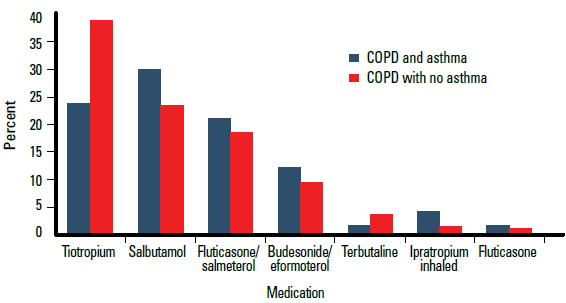One in 20 Australian general practice patients suffer from COPD (one in 10 for patients aged 65 years or older). One in 5 are classified at the highest severity level (by the Global Initiative for Chronic Obstructive Lung Disease [GOLD] guidelines). Diagnosis is complex and multiple factors are considered in its determination. The common presence of asthma as a comorbidity complicates diagnosis and increases the complexity of COPD management.
The prevalence of diagnosed COPD was 5.2% (95% CI: 4.4–6.0). There was no significant difference in the sex-specific prevalence of diagnosed COPD between male (5.9%) and female patients (4.7%). Prevalence increased with patient age, the age specific rates of COPD being 5.3% in patients aged 45–64 years; 11.5% in patients aged 65–74 years and 11.7% in patients aged 75 years or older. Of these, 43% also had diagnosed asthma.
Severity of COPD was reported for 288 of the 296 patients with diagnosed COPD. Severity was classified according to the GOLD guidelines. Of the 288 patients, 40.3% were categorised as having mild COPD; 38.9% had moderate COPD; 13.9% had severe COPD and 6.9% had very severe COPD.
General practitioners were asked to record the factors contributing to the diagnosis of COPD for each patient, and were given options of ‘clinical history/symptoms’, ‘nonresponse to bronchodilator’, ‘smoking history’, ‘environmental irritants’, ‘spirometry’ and ‘chest X-ray’. For 292 patients, GPs responded to at least one part of this question. Clinical history had been a factor contributing to COPD diagnoses for 84.9% of patients; smoking history for 79.5%; spirometry for 60.3%; chest X-ray for 56.5%; no response to bronchodilator for 21.2% and environmental irritants for 11.0%.
Medication was used for COPD management by 82.8% of patients (17.2% ticked ‘no medication’). Tiotropium is considered first-line therapy for COPD1 and was most commonly reported for patients with COPD without asthma. Where patients had both conditions, tiotropium was the second most commonly reported medication, following salbutamol. Figure 1 shows the medications most commonly reported for COPD management, with and without asthma.

Figure 1. Medications used for the management of COPD with and without asthma
Acknowledgements
The authors thank the GP participants in BEACH and all members of the BEACH team. Funding contributors to BEACH between April 2009 to March 2012: Abbott Australasia Pty Ltd; Australian Government Department of Health and Ageing; AstraZeneca Pty Ltd (Australia); Bayer Australia Ltd; CSL Biotherapies Pty Ltd; GlaxoSmithKline Australia Pty Ltd; Janssen-Cilag Pty Ltd; Merck, Sharp and Dohme (Australia) Pty Ltd; Novartis Pharmaceuticals Australia Pty Ltd; Pfizer Australia; Sanofi-Aventis Australia Pty Ltd. This SAND sub-study was undertaken in collaboration with Novartis Pharmaceuticals Australia Pty Ltd. BEACH and all SAND sub-studies are approved by the Human Research Ethics Committee of the University of Sydney.